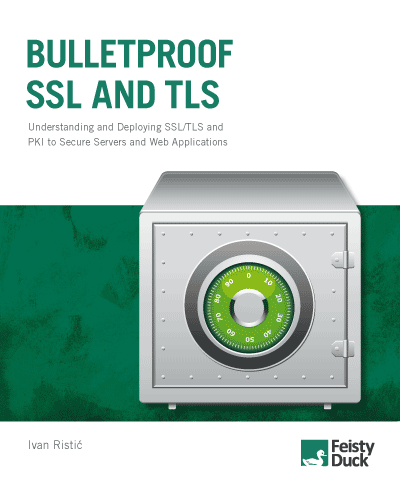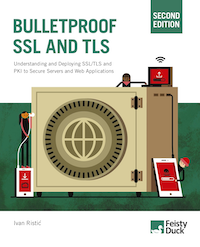Bulletproof SSL and TLS May Update: Deployment and Performance
May 20, 2014

I've just released the May update of Bulletproof SSL and TLS. This batch brings 78 pages and three chapters to the book:
- Chapter 8, Deployment, is the map for the entire book and provides step by step instructions on how to deploy secure and well-performing TLS servers and web applications.
- Chapter 9, Performance, focuses on the speed of TLS, providing more detail as well as additional performance improvement techniques for those who want to squeeze every bit of speed out of their servers.
- Chapter 10, HSTS, CSP, and Pinning, covers some advanced topics that strengthen web applications, as well as pinning, which is a way of reducing the large attack surface imposed by our current PKI model.
In addition, improvements were made to existing chapters:
- Chapter 7, Protocol Attacks, has been completely revised in response to the excellent technical reviews I received.
- Heartbleed is now fully documented, with the main coverage in Chapter 6 and detailed testing instructions in Chapter 11.
Overall, book is currently at 420 pages. Previous chapters include:
- Chapter 4, Attacks against PKI, deals with attacks on trust. It covers all the major CA compromises as well as some other ways to subvert TLS authentication on the Internet.
- Chapter 5, HTTP and Browser Issues, is all about the relationship between HTTP and SSL, the problems arising from the organic growth of the Web, and the messy interactions between different pieces of the web ecosystem.
- Chapter 6, Implementation Flaws, deals with issues arising from design and programming mistakes related to random number generation, certificate validation, and other key TLS and PKI functionality. Additionally, it discusses voluntary protocol downgrade and truncation attacks.
- Chapter 7, Protocol Attacks, is the longest chapter in the book at 60 pages. It covers all major protocol flaws discovered in recent years: Insecure Renegotiation, BEAST, CRIME, Lucky 13, RC4, TIME and BREACH, Triple Handshake, and the Bullrun program.
- Chapter 10, OpenSSL Cookbook, describes the most frequently used OpenSSL functionality, largely focusing on installation, configuration, and key and certificate management. This is the most polished chapter, given that it had been released as a standalone short book in May 2013, and then updated in October.
- Chapter 11, Testing with OpenSSL, continues with OpenSSL and explains how to use its command-line tools to test server configuration. Even though it is often much easier to use an automated tool for testing (e.g., the SSL Labs Server Test), OpenSSL remains the de facto standard for troubleshooting.
- Chapter 12, Configuring Apache, discusses the SSL configuration of Apache httpd.
- Chapter 13, Configuring Java and Tomcat, covers the current versions of Java and Tomcat, and gives a glimpse of what's coming in Java 8. (Java 8 coverage will improve soon after Oracle makes the final release candidate available.)
- Chapter 14, Configuring Microsoft Windows and IIS, discusses the Microsoft Windows platform and the Internet Information Server.
- Chapter 15, Configuring Nginx, discusses the Nginx web server, covering the features in the stable and development version equally.
The book is now almost complete. The remaining chapters, which will be released in the next batch in June, will provide the necessary background in cryptography, SSL and TLS protocols, and PKI.
If you already have access to the book, here's the direct link to access the new content:
https://www.feistyduck.com/library/bulletproof/
If you don't have access yet, Bulletproof SSL and TLS is available now for early access and preorder, at a 20% discount:
https://www.feistyduck.com/books/bulletproof-ssl-and-tls/
 |
MY BOOK: If you like this blog post, you will love Bulletproof TLS and PKI. For system administrators, developers, and IT security professionals, this book provides a comprehensive coverage of the ever-changing field of SSL/TLS and Internet PKI and will teach you everything you need to know to protect your systems from eavesdropping and impersonation attacks. It's available now. |


